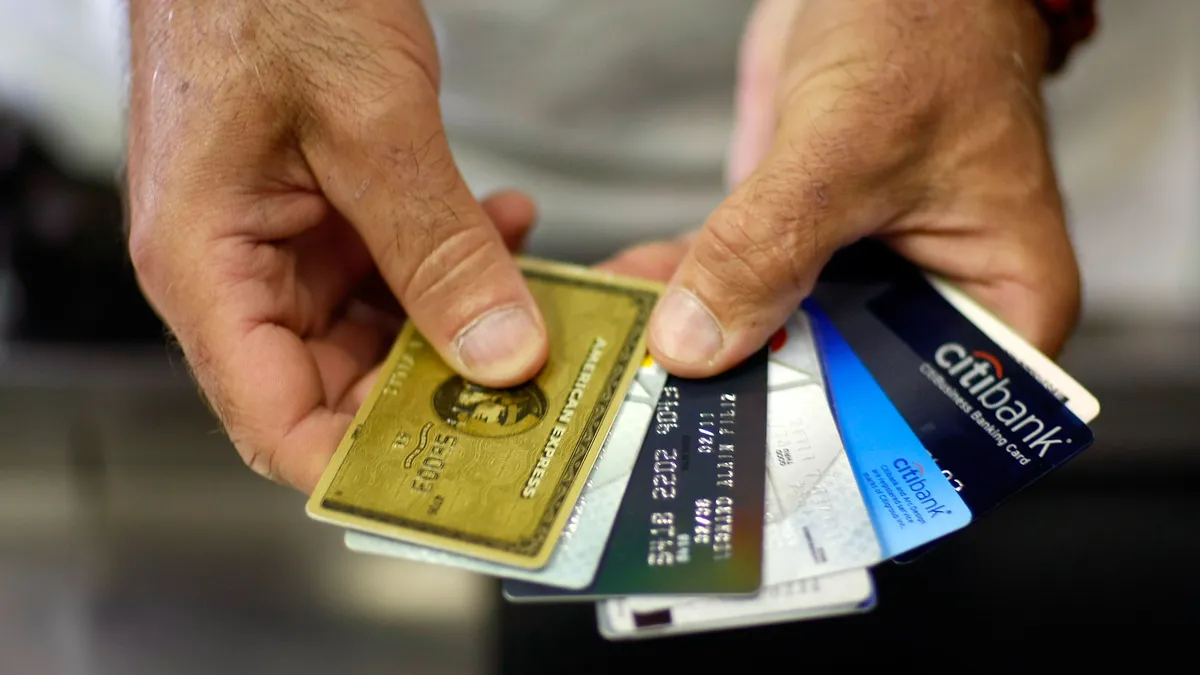Payments cards are getting increasingly expensive as banks and other card issuers face shortages of computer chips, industry analysts say.
An analysis published by industry research firm The Nilson Report forecasts prices for finished, first-use plastic cards will increase between 5% and 20% this year and next year. Prices also rose in 2021.
“These increases follow multiple years of price declines for finished cards preceding the Covid-19 pandemic,” Nilson said in its April edition.
The U.S. companies JPMorgan Chase, Citibank and American Express are among the biggest credit card issuers in the world. A spokesperson for JPMorgan Chase said: "We have no expected impacts."
The American Bankers Association declined comment other than to reference a November letter on the topic that it submitted last year to the U.S. Department of Commerce. "This is a fluid situation and exact predictions are difficult to make," the Nov. 8 letter said. "However, without an adequate chip supply, some payment card issuers could potentially face challenges in consistently delivering the timely replacement of chip cards or issuing new chip cards to meet consumer and business demand in the U.S."
Nilson’s views were echoed by Phil Sealy, a research director for digital security at New York-based ABI Research, a global technology research and consulting firm.
“There have been several increases in prices over the course of the last 12 to 24 months,” said Sealy in an interview. “There likely will be another increase coming shortly.”
Average selling prices for chips are between 10% and 20% this year and an additional increase is expected by the end of the year, Sealy said.
An August 2021 ABI report said as many as 1 billion payments cards were at risk of not being made over an 18-month period because of a chip shortage. ABI is in the process of updating its forecast and declined to discuss its research before publication.
Ukraine companies shutter
The conflict between Russia and Ukraine is affecting chip prices because Ukraine is home to two companies that produce half the world’s supply of neon, a key ingredient in making chips, Sealy said.
According to Reuters, the Ukrainian companies, Ingas, based in Mariupol, and Cryoin, based in Odessa, shut their doors when the war started earlier this year.
Chipmakers use neon to control the specialized lasers they use to make semiconductors. Prices for Neon have skyrocketed since the invasion of Ukraine. According to the South China Morning Post, the average wholesale price of industrial-grade neon in China has jumped nearly nine-fold since the invasion began.
About 80% of the card market is related to the re-issuance of expiring cards, Sealy said, adding that manufacturers have to appease their client base by prioritizing old accounts over new ones.
"Higher prices paid by card issuers present the dilemma of whether to pass along their increased cost to consumers,” according to The Nilson Report. “Charging more for the same plastic is not a good position to be in. If consumers are going to be asked to pay more, the opportunity exists to migrate them to a card perceived to be of greater value such as one made of metal.”
Chip supplies were already tight before the pandemic began in March 2020 due to increased demand from the automobile industry and telecommunications companies deploying high-speed 5G service, among other reasons, said Barb Else, Fiserv’s vice president of output solutions.
“Disruptions caused by the COVID-19 pandemic and global labor supply challenges have exacerbated the shortage, which is projected to possibly continue until 2024,” Else said in an emailed statement. “Financial institutions can mitigate the impact of chip shortages by developing and maintaining a rolling 12-month forecast of chip and card needs and sharing those forecasts with their card manufacturers.”
Some slower delivery times
For the moment, at least one chip manufacturer, Infineon Technologies, is still meeting its commitments, if not all of the demand, for chips from its payment card customers, said Oliver Manahan, a senior director for business development at Infineon. The trick is staying in closer touch with customers about their needs and being realistic about the supply that will be available, said Manahan.
The biggest change now, in the tighter supply market, is that if customers decide they want to increase an order, that typically isn't possible, Manahan said.
While the company is meeting the commitments of its existing customers on a normal timetable because it had forecasts for them, new customers that weren't part of its forecast will have to wait longer for deliveries, at least 52 weeks, as opposed to less than 18 weeks in the past, he said.
Fiserv has told customers to place card orders four to five months sooner than usual because of the longer lead times for chip shipments, and to expect price hikes. Being flexible about any design changes or major promotions until the supply chain issues are resolved would also be helpful, according to Else.
Fiserv conducts weekly status meetings with its vendors to assess current chip availability and determine future delivery schedules. With input from vendors, Fiserv has identified new chips that could be used in cards.
Correction: This story has been updated to correct the reference to Infineon wait times in the past, and to clarify that Manahan said the company is meeting its commitments, not satisfying all demand for chips from its customers.


















